cooling CITROEN DS3 CABRIO DAG 2016 Handbook (in English)
[x] Cancel search | Manufacturer: CITROEN, Model Year: 2016, Model line: DS3 CABRIO DAG, Model: CITROEN DS3 CABRIO DAG 2016Pages: 458, PDF Size: 14.51 MB
Page 37 of 458
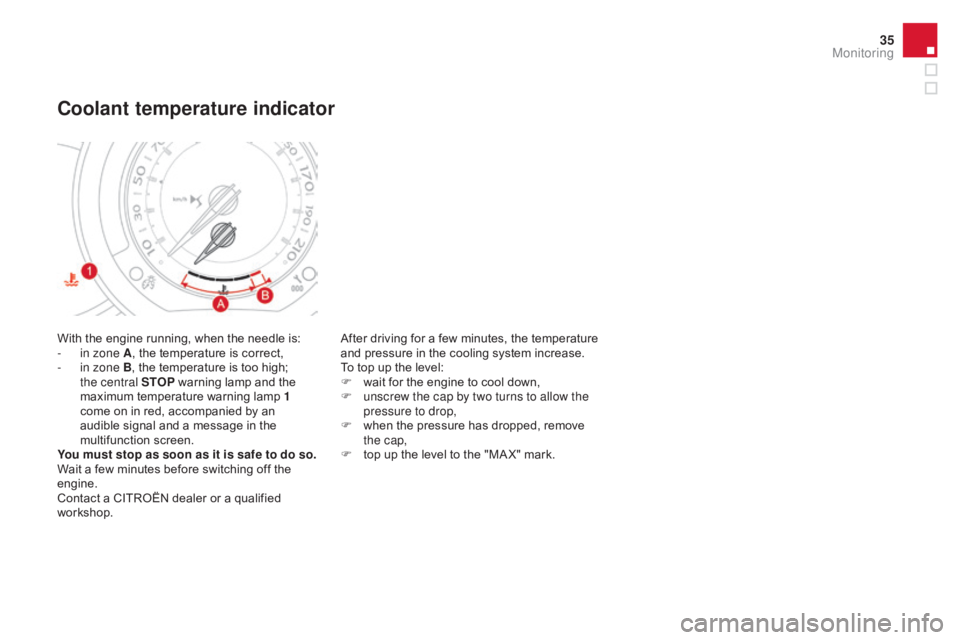
35
DS3_en_Chap01_controle-de-marche_ed01-2015
With the engine running, when the needle is:
- i n zone A ,
the temperature is correct,
-
i
n zone B, the temperature is too high;
t
he central STOP
warning lamp and the
m
aximum temperature warning lamp 1
come
on in red, accompanied by an
a
udible signal and a message in the
m
ultifunction
s
creen.
You must stop as soon as it is safe to do so.
Wait
a few minutes before switching off the
e
ngine.
Contact
a CITROËN dealer or a qualified
w
orkshop.
Coolant temperature indicator
After driving for a few minutes, the temperature and pressure in the cooling system increase.
To
top up the level:
F
w
ait for the engine to cool down,
F
u
nscrew the cap by two turns to allow the
pressure to drop,
F
w
hen the pressure has dropped, remove
t
he cap,
F
t
op up the level to the "MA X" mark.
Monitoring
Page 83 of 458
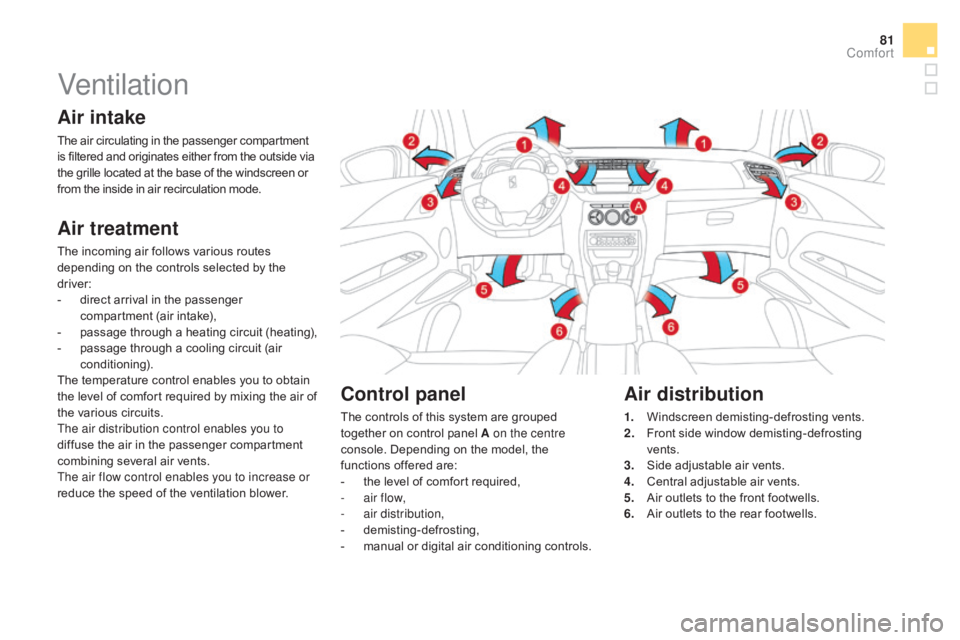
81
DS3_en_Chap03_confort_ed01-2015
Ventilation
Air intake
The air circulating in the passenger compartment is filtered and originates either from the outside via t
he grille located at the base of the windscreen or
f
rom the inside in air recirculation mode.
Air treatment
The incoming air follows various routes depending on the controls selected by the
d
river:
-
d
irect arrival in the passenger
c
ompartment (air intake),
-
p
assage through a heating circuit (heating),
-
p
assage through a cooling circuit (air
c
onditioning).
The
temperature control enables you to obtain
t
he level of comfort required by mixing the air of
t
he various circuits.
The air distribution control enables you to
diffuse
the air in the passenger compartment
c
ombining several air vents.
The air flow control enables you to increase or
reduce
the speed of the ventilation blower.
Control panel
The controls of this system are grouped together on control panel A on the centre
console.
Depending on the model, the
f
unctions offered are:
-
t
he level of comfort required,
-
a
ir flow,
-
a
ir distribution,
-
d
emisting-defrosting,
-
m
anual or digital air conditioning controls.
Air distribution
1. Windscreen demisting-defrosting v ents.
2. F ront side window demisting-defrosting
ve
nts.
3.
S
ide adjustable air vents.
4.
C
entral adjustable air vents.
5.
A
ir outlets to the front footwells.
6.
A
ir outlets to the rear footwells.
Comfort
Page 89 of 458
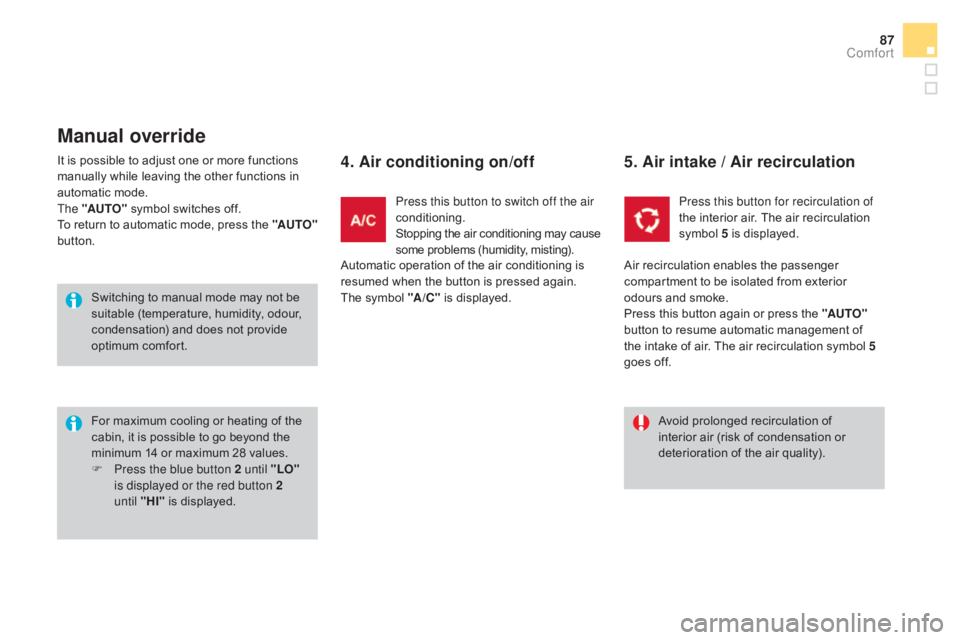
87
DS3_en_Chap03_confort_ed01-2015
It is possible to adjust one or more functions manually while leaving the other functions in
a
utomatic mode.
The "AUTO"
symbol switches off.
To
return to automatic mode, press the "AUTO"
button.
Manual override
4. Air conditioning on/off
For maximum cooling or heating of the c abin, it is possible to go beyond the
m
inimum 14 or maximum 28 values.
F
P
ress the blue button 2 until "LO"
is displayed or the red button 2
until
"HI"
is displayed. Press this button to switch off the air
conditioning.
Stopping
the air conditioning may cause
s
ome problems (humidity, misting).
5. Air intake / Air recirculation
Press this button for recirculation of
the
interior air. The air recirculation
s
ymbol
5
is displayed.
Avoid
prolonged recirculation of
i
nterior air (risk of condensation or
d
eterioration of the air quality).
Switching
to
manual
mode
may
not
be
s
uitable
(temperature,
humidity,
odour,
c
ondensation)
and
does
not
provide
o
ptimum
c
omfort. Automatic
operation
of
the
air
conditioning
is
r
esumed
when
the
button
is
pressed
again.
The
symbol
"A /C "
is
displayed. Air
recirculation enables the passenger
c
ompartment to be isolated from exterior
o
dours
and smoke.
Press
this
button again or press the "AUTO"
button
to
resume automatic management of
t
he
intake
of air. The air recirculation symbol 5
goes
off.
Comfort
Page 222 of 458
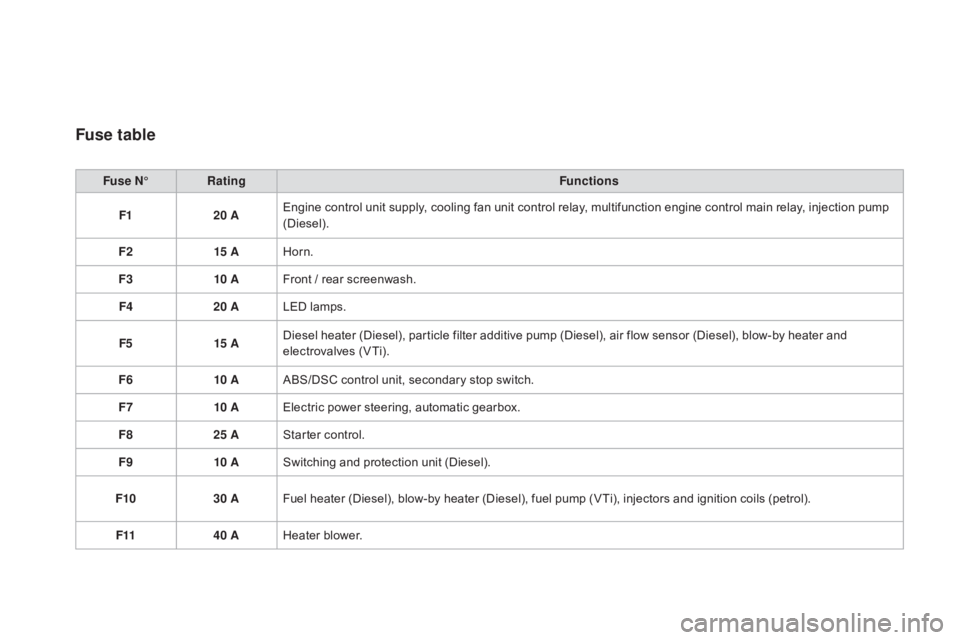
DS3_en_Chap08_info-pratiques_ed01-2015
Fuse table
Fuse n°R ating Functions
F1 20 AEngine
control unit supply, cooling fan unit control relay, multifunction engine control main relay, injection pump
(
Diesel).
F2 15 AHorn.
F3 10 AFront
/ rear screenwash.
F4 20 ALED
lamps.
F5 15 ADiesel
heater (Diesel), particle filter additive pump (Diesel), air flow sensor (Diesel), blow-by heater and
e
lectrovalves (VTi).
F6 10 AABS/DSC
control unit, secondary stop switch.
F7 10 AElectric
power steering, automatic gearbox.
F8 25 AStarter
control.
F9 10 ASwitching
and protection unit (Diesel).
F10 30 AFuel
heater (Diesel), blow-by heater (Diesel), fuel pump (VTi), injectors and ignition coils (petrol).
F11 40 AHeater
b
lower.
Page 224 of 458
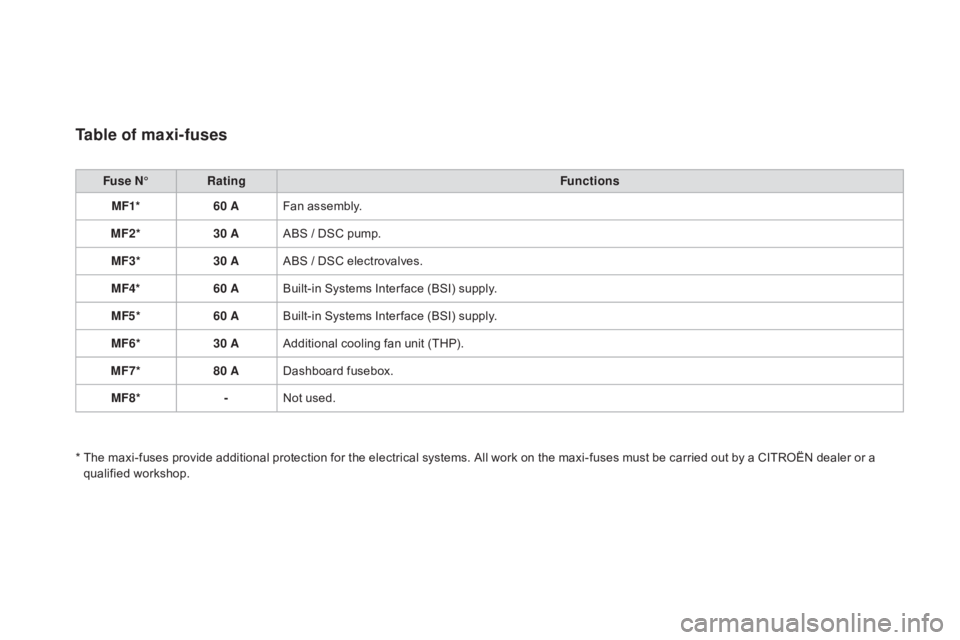
DS3_en_Chap08_info-pratiques_ed01-2015
Table of maxi-fuses
Fuse n°R ating Functions
MF1* 60 AFan
assembly.
MF2* 30 AABS
/ DSC pump.
MF3* 30 AABS
/ DSC electrovalves.
MF4* 60 ABuilt-in
Systems Inter face (BSI) supply.
MF5* 60 ABuilt-in
Systems Inter face (BSI) supply.
MF6* 30 AAdditional
cooling fan unit (THP).
MF7* 80 ADashboard
f
usebox.
MF8* -Not
used.
*
T
he maxi-fuses provide additional protection for the electrical systems. All work on the maxi-fuses must be carried out by a CITROËN dealer or a
q
ualified
w
orkshop.
Page 233 of 458
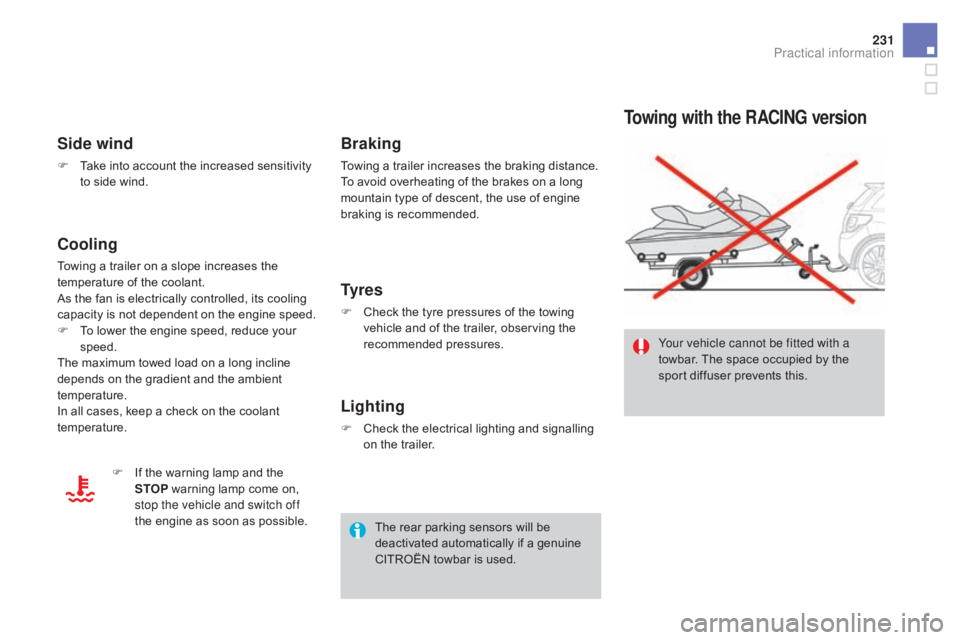
231
DS3_en_Chap08_info-pratiques_ed01-2015
Towing with the RACIng version
Your vehicle cannot be fitted with a
towbar.
The space occupied by the
s
port diffuser prevents this.
Side wind
F Take into account the increased sensitivity t
o side wind.
Cooling
Towing a trailer on a slope increases the temperature of the coolant.
As
the fan is electrically controlled, its cooling
c
apacity is not dependent on the engine speed.
F
T
o lower the engine speed, reduce your
s
peed.
The
maximum towed load on a long incline
d
epends on the gradient and the ambient
t
emperature.
In
all cases, keep a check on the coolant
t
emperature. F
I
f the warning lamp and the
S
TOP
warning lamp come on,
s
top the vehicle and switch off
the
engine as soon as possible.
Braking
Towing a trailer increases the braking distance.
T o avoid overheating of the brakes on a long
m
ountain type of descent, the use of engine
b
raking is recommended.
Ty r e s
F Check the tyre pressures of the towing v
ehicle and of the trailer, observing the
re
commended
p
ressures.
Lighting
F Check the electrical lighting and signalling o
n the trailer.
The
rear parking sensors will be
d
eactivated automatically if a genuine
C
ITROËN towbar is used.
Practical information
Page 244 of 458
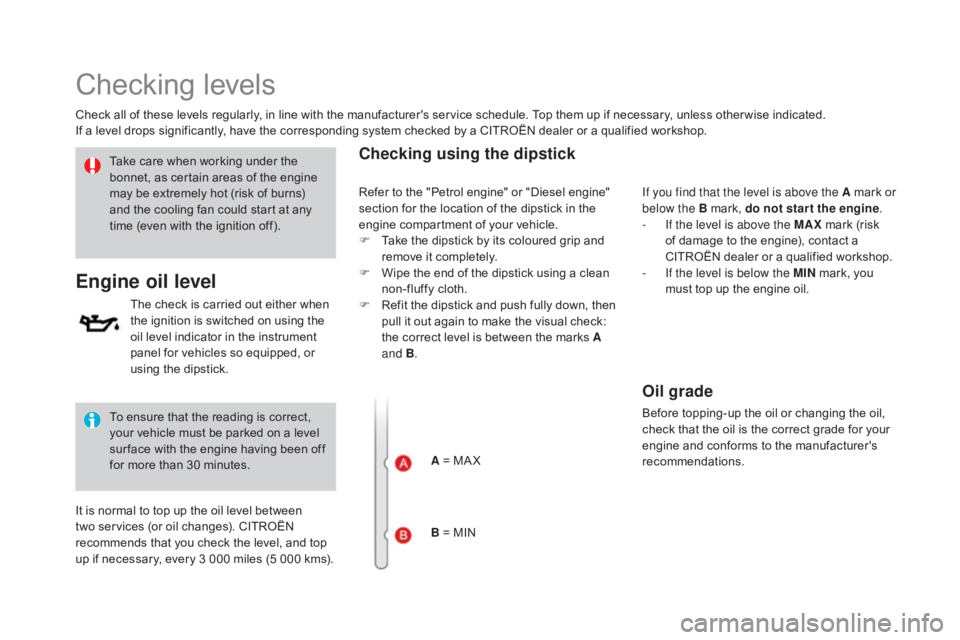
Checking levels
Check all of these levels regularly, in line with the manufacturer's service schedule. Top them up if necessary, unless other wise indicated.
I f a level drops significantly, have the corresponding system checked by a CITROËN dealer or a qualified workshop.
Engine oil level
It is normal to top up the oil level between two services (or oil changes). CITROËN
r
ecommends that you check the level, and top
u
p if necessary, every 3 000 miles (5 000 kms).
The
check is carried out either when
t
he ignition is switched on using the
o
il level indicator in the instrument
p
anel for vehicles so equipped, or
u
sing the dipstick.
To ensure that the reading is correct,
y
our vehicle must be parked on a level
s
ur face with the engine having been off
f
or more than 30 minutes.
Take care when working under the
b
onnet, as certain areas of the engine
m
ay be extremely hot (risk of burns)
a
nd the cooling fan could start at any
t
ime (even with the ignition off).
Checking using the dipstick
A = MA X
B = MIN If you find that the level is above the A
mark or
belo
w the B mark, do not star t the engine
.
-
I
f the level is above the MAX
mark (risk
o
f damage to the engine), contact a
C
ITROËN dealer or a qualified workshop.
-
I
f the level is below the MI n
mark, you
m
ust top up the engine oil.
Refer
to
the
"Petrol engine" or "Diesel engine"
s
ection
for
the location of the dipstick in the
e
ngine
compartment of your vehicle.
F
T
ake
the
dipstick by its coloured grip and
r
emove
it completely.
F
W
ipe
the
end of the dipstick using a clean
n
on-fluffy cloth.
F
R
efit
the
dipstick and push fully down, then
p
ull
it
out again to make the visual check:
t
he
correct level is between the marks A
and B .
Oil grade
Before topping-up the oil or changing the oil, c
heck that the oil is the correct grade for your
e
ngine and conforms to the manufacturer's
r
ecommendations.
Page 246 of 458
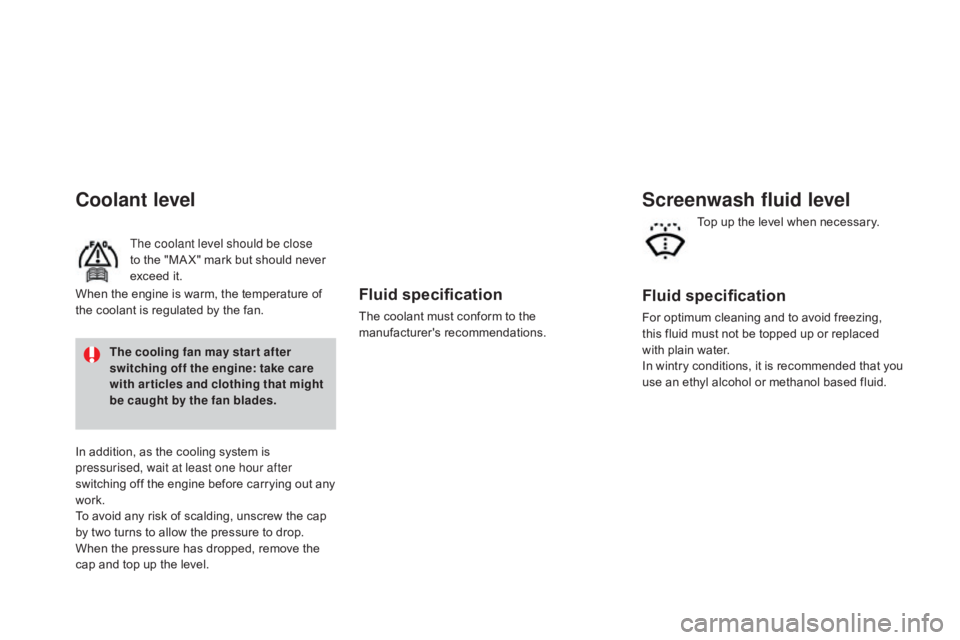
Fluid specification
The coolant must conform to the manufacturer's r ecommendations.
Coolant level
The coolant level should be close
to the "MA X" mark but should never
e
xceed it.
In
addition, as the cooling system is
p
ressurised, wait at least one hour after
switching
off the engine before carrying out any
wo
rk.
To
avoid
any risk of scalding, unscrew the cap
b
y
two
turns to allow the pressure to drop.
W
hen
the
pressure has dropped, remove the
c
ap
and
top up the level.
When
the
engine is warm, the temperature of
t
he
coolant is regulated by the fan.
The cooling fan may star t after
switching off the engine: take care
with articles and clothing that might
be caught by the fan blades.
Screenwash fluid level
Fluid specification
For optimum cleaning and to avoid freezing, t his fluid must not be topped up or replaced
w
ith plain water.
In
w
intry
c
onditions,
i
t
i
s
r
ecommended
t
hat
y
ou
u
se an ethyl alcohol or methanol based fluid.
Top
up the level when necessary.